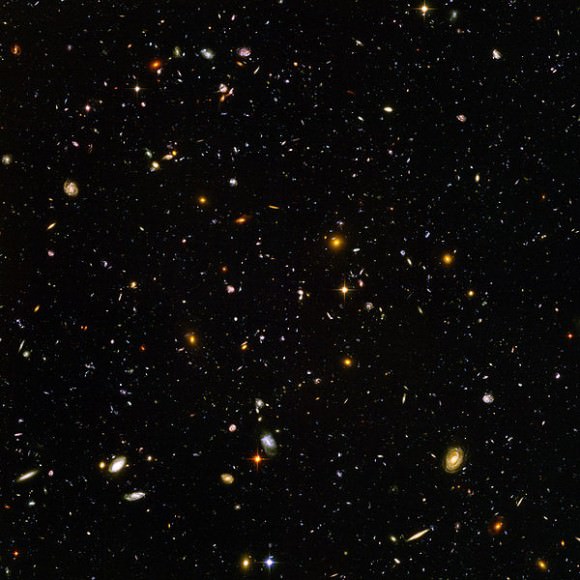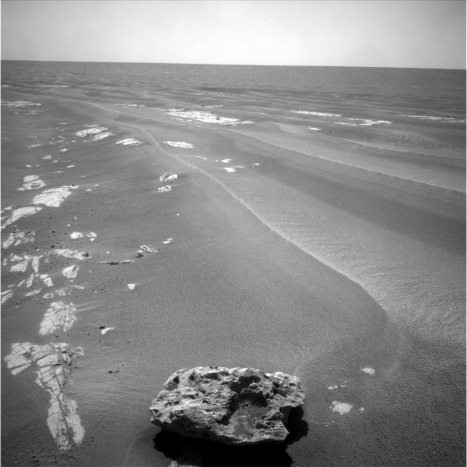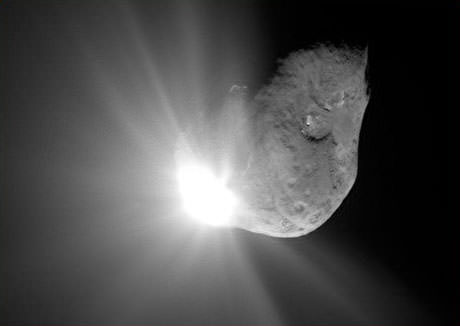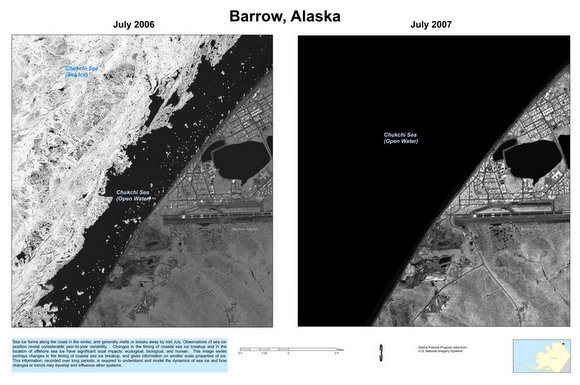Half Comet-Half Asteroid a Fluke? Nope

Back in 1996, astronomers discovered a strange object in the asteroid belt. They decided it was either a "lost" comet or an icy asteroid, as it ejected dust like a comet but had an orbit like an asteroid. No one had ever seen anything like the object, called 133P. Ever since it was found, astronomers have wondered if it was just an oddity — one of a kind. We now know it is not, and the discovery of more of these half asteroids/half comets means there is a new class of objects in our solar system.
(...)
Read the rest of Half Comet-Half Asteroid a Fluke? Nope (312 words)
LCROSS Sees Life on Earth
The LCROSS spacecraft took a look back at Earth, and guess what it saw? Evidence of intelligence? Not so much. But it did see evidence of life. On Aug. 1, 2009, the LCROSS spacecraft took a gander at Earth to help calibrate and test its science payload. During the Earth observations, the spacecraft's spectrometers were able to detect the signatures of the Earth's water, ozone, methane, oxygen, carbon dioxide and possibly vegetation.
(...)
Read the rest of LCROSS Sees Life on Earth (281 words)
Plains of Titan to be Named for "Dune" Novels

Titan's mysterious dark plains will be named after planets in the series of "Dune" science fiction novels by author Frank Herbert. The US Geological Survey Astrogeology Science Center announced the first plain or "planitia" given a name will be designated as Chusuk Planitia. Chusuk was a planet from the Dune series, known for its musical instruments. Chusuk Planitia is located at 5.0S, 23.5W, and in the picture here is the small, dark area next to the "C" of Chusuk.
(...)
Read the rest of Plains of Titan to be Named for "Dune" Novels (305 words)
Astro Art of the Week: Dragon Vs. Eagle
Here's the fourth installment of our new feature, showcasing our readers' prowess with image editing software. This week's Astro Art of the Week is a showdown of cosmic proportions: "Dragon Versus Eagle" was submitted by Wienie van der Oord from Negev Desert in Israel.
The image of the Eagle Nebula was taken by Wienie's friend, Kfir Simon, with a DSI 3 pro, HAlpha filter and a Canon with 200mm lens. You can see more of Kfir's astrophotography here. . Thanks Wienie and Kfir!
Also, we're still contemplating a good title for this feature. We've tried "Astro 'Shop of the Week," (as in 'Photoshop') and now "Astro Art of the Week." If you have any suggestions for a good title, post it in the comment section. Thanks!
How Many Galaxies Have We Discovered?
Astronomers think that there are hundreds of billions galaxies in the universe, however the exact number is not known. But astronomers should know how many galaxies we've actually seen and discovered, right? Well, not necessarily. “We don’t know,” says Ed Churchwell, professor of astronomy at the University of Wisconsin-Madison. “We know it’s a very large number.” In just one image for example, the Hubble Ultra Deep Field, above, there are about 10,000 galaxies visible.
(...)
Read the rest of How Many Galaxies Have We Discovered? (313 words)
Opportunity Spies Unusual Rock — Large Meteorite?
The Opportunity rover has come across an odd-shaped, large, dark rock, about 0.6 meters (2 feet) across on the surface of Mars, which may be a meteorite. The rover team spotted the rock called "Block Island," on July 18, 2009, in the opposite direction from which it was driving. The team then had the rover do a hard right (not really, but you know what I mean) and backtrack some 250 meters (820 feet) to study it closer. Oppy has been studying the rock with its alpha particle X-ray spectrometer to get composition measurements and to confirm if indeed it is a meteorite.
Below, see a close-up, colorized version of Block Island and a 3-D version, both created by Photoshopper Extraordinaire Stu Atkinson.
(...)
Read the rest of Opportunity Spies Unusual Rock — Large Meteorite? (151 words)
Top Five Celestial Objects Anyone Can See With a Small Telescope
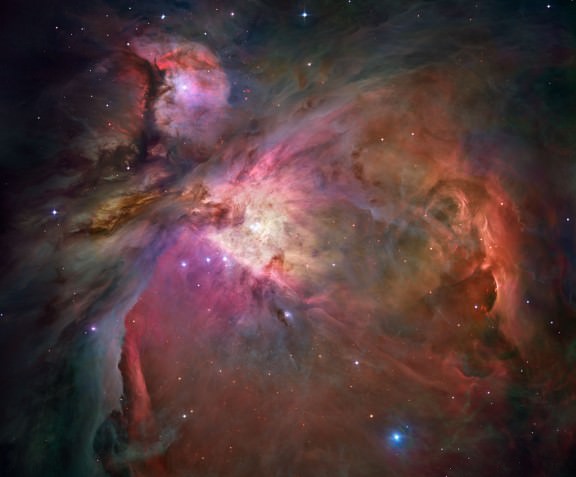
Popular Mechanics has a great series of articles today on amateur astronomy, including Affordable Ways to Become an Amateur Astronomer, and How to Computerize Your Telescope. But my favorite is the Top Five Galactic Bodies Anyone Can See With a Cheap Telescope. Number one on the list is the Orion Nebula, above. Granted, with small telescopes, it won't look like this Hubble Space Telescope image, but The Great Nebula is even visible with the naked eye in the northern hemisphere, and looks pretty impressive in small telescope, too. To find it, those in the northern hemisphere will have to wait until cooler weather approaches. But look for Orion's belt, three bright stars in a row. Hanging south from the belt is Orion's sword, composed of three bright dots; the center dot is the great nebula.
(...)
Read the rest of Top Five Celestial Objects Anyone Can See With a Small Telescope (335 words)
Sub-surface Oceans In Early Comets Suggest Possible Origin of Li
A new study claims early comets contained vast interior oceans of liquid water that may have provided the ideal conditions for early life to form.
(...)
Read the rest of Sub-surface Oceans In Early Comets Suggest Possible Origin of Life (299 words)
Galaxies Bring Dancing With the Stars to New Level

What is small, mysterious, faint, in the process of losing mass, and can dance like crazy? Could it be Marie Osmond? Well, that might be the correct answer in this galaxy, but just on the outskirts of the Milky Way are small, mysterious galaxies called dwarf spheroidal galaxies, and a new study offers an explanation for the origin of these puzzling objects. But can they really dance? Yes, says lead author Elena D'Onghia of the Harvard-Smithsonian Center for Astrophysics.
(...)
Read the rest of Galaxies Bring Dancing With the Stars to New Level (343 words)
Newly Discovered Cometary Route Sneaks Past Jupiter, but Decreas
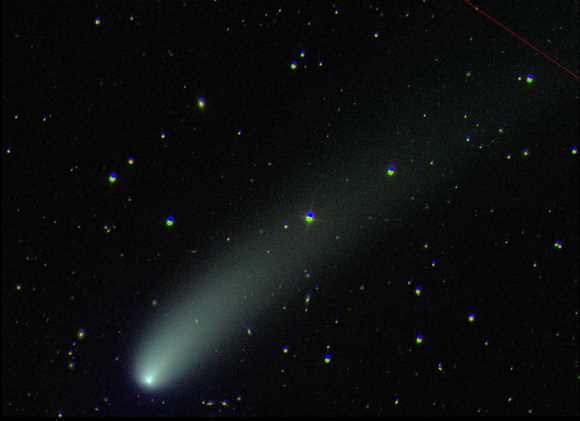
Astronomers have used the comet record — including 2001 RX14 (Linear) at left, captured in 2002 by the Sloan Digital Sky Survey — to model a new route for incoming comets that sneaks past Jupiter's gravity.
The pathway might even be the dominant one that delivers Oort Could comets on an Earth-bound trajectory, say the authors of a new study in Science this week — but if that's true, comets only rarely cause extinctions on Earth.
(Image credit: Mike Solontoi/University of Washington)
(...)
Read the rest of Newly Discovered Cometary Route Sneaks Past Jupiter, but Decreases Risk of Earth Impacts (747 words)
NASA Science News for August 6, 2009
NASA's new planet-hunting Kepler space telescope has detected the changing phases and atmosphere of a planet a thousand light years away.
FULL STORY at
http://science.nasa.gov/headlines/y2009/06aug_kepler2.htm?list1035898
NASA Science News for August 3, 2009
Two weeks after something slammed into Jupiter, creating a cloud of debris that is still easy to see through backyard telescopes, researchers are wondering ... what was the impactor?
FULL STORY at
http://science.nasa.gov/headlines/y2009/03aug_whathitjupiter.htm?list1035898
NASA Science News for July 31, 2009
Earth is entering a stream of debris from Comet Swift-Tuttle, setting the stage for the 2009 Perseid meteor shower.
FULL STORY at
http://science.nasa.gov/headlines/y2009/31jul_perseids2009.htm?list1035898
Declassified Ice Loss Images
Last week the US government released more than a thousand intelligence images of Arctic ice that have been used to help scientists study the impact of climate change. The images were taken by spy satellites, as part of the Medea program, which lets scientists request spy pictures from environmentally sensitive locations around the world. After they were taken, the Bush Administration released the photographs to the scientists but deemed them "unsuitable for public release." Earlier this month, the National Academy of Sciences recommended the Obama Administration declassify the photos, which they did within a few hours of the recommendation.
Various blogs are saying these dramatic images are faked, but since they are available through the US Geological Survey , that hardly seems likely. Over 700 images show changes of sea ice in various recent years from six sites around the Arctic Ocean, with an additional 500 images of 22 sites in the United States.
(...)
Read the rest of Declassified Ice Loss Images (87 words)
Giant Soap Bubble In Space
What looks like a giant soap bubble or even perhaps just a water drop on a camera lens is actually a newly discovered planetary nebula. Dave Jurasevich of the Mount Wilson Observatory in California spotted the "Cygnus Bubble" while recording images of the region in July 2008. A few days later, amateur astronomers Mel Helm and Keith Quattrocchi also found it. Then, in 2009, the Kitt Peak Observatory pointed its 4-meter Mayall telescope at the object, and created the image above. Spectacular!
(...)
Read the rest of Giant Soap Bubble In Space (162 words)


